Original URL: https://www.theregister.com/2008/11/07/review_handheld_games_consoles/
Handheld games console three-way shoot-out
PSP vs DS vs… iPod Touch
Posted in Personal Tech, 7th November 2008 13:02 GMT
Round-up For the last few years, the handheld games market has been dominated by the now-traditional rivalry between Sony’s PlayStation Portable and the Nintendo DS Lite. This year, though, there’s a surprise new kid on the gaming block: Apple’s second-gen iPod Touch.
Apple is touting the new Touch as "the funnest iPod ever" (sic), and wants to make a strong selling point out of the device’s gaming abilities. Some of the games that we’ve seen for the Touch certainly look quite impressive, so we decided to take all three contenders in hand and check out their gaming credentials – as well as their wider capabilities in areas such as music, video and internet browsing.
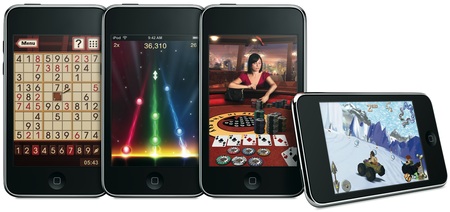
Apple’s 2G iPod Touch: handheld games machine
The unexpected evolution of the iPod Touch is a side-effect of the huge success of Apple’s iPhone. Apple has sold more than ten million iPhones in the last 12 months, and this has prompted a flood of games for the device. The iPod Touch has the same touchscreen controls, motion sensor and operating system as the iPhone, which means that it can play the same range of games. Apple slapped a small speaker onto the new 2G model so that you can play games without wearing earphones and – hey presto! – instant games machine.
Admittedly, the iPod Touch might seem a bit expensive for a handheld games console, but with prices starting at £169 for the 8GB model it’s only slightly more expensive than the updated PSP-3000, which was released in October at £150 — although you can still get bundles including the previous ‘slim and lite’ PSP plus one or two games for around £130. The 3.5in widescreen display of the iPod Touch provides a clear and colourful image that’s well suited to mobile games – though it’s not as large as the 4.3in screen of the PSP.
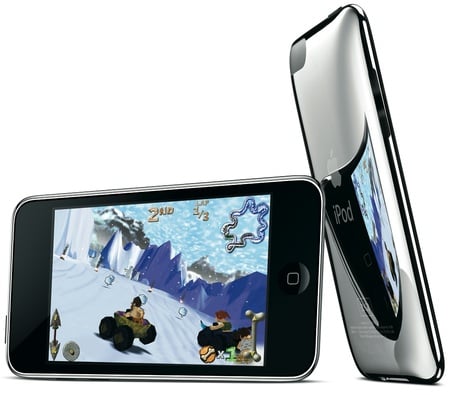
Cro-mag Rally on the iPod Touch
But, as the name implies, it’s the touch-screen control system that’s the Touch’s the big selling point. The ability to just tap or flick your finger across the iPod screen to control a game is a logical progression from the tapping approach of the DS – and you don’t have to worry about losing the stylus either. However, the really neat trick is the motion-sensor that allows you to control games simply by tilting the device from side to side. This works really well when playing racing games such as Crash Bandicoot, where the entire iPod effectively acts as the steering wheel, or games like iBall 3D, in which you roll a marble around the screen.
Of course, fancy hardware means nothing unless you’ve got a good selection of games to play. It’s still early days for the iPod Touch and it can’t yet match the sheer variety of games that are on offer for the PSP or the DS. However, the phenomenal success of the iPhone has already attracted some big names. Recent releases on the iTunes App Store include such A-list titles as Spore and Star Wars: The Force Unleashed. These aren’t the full versions of the games that you’d buy for the DS or PSP, but they don’t come at full price either. Both those games cost £6, compared to around £25 for the DS and PSP versions, and there’s a good selection of less expensive arcade games such as Pac-Man and Tetris for £3–5 each. There’s also quite a large number of free games. One of the top free downloads from the App Store at the moment is Touch Hockey, a game that lets you flick a hockey puck around the screen with your finger.
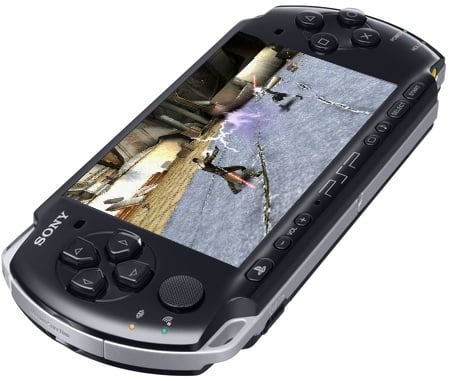
Sony’s PSP: only for red-blooded gamers?
While the early signs for iPod Touch games are encouraging, the fact remains that the iPod is still massively outgunned by the vast selection of games that are available for the PSP and DS Lite. Both devices can boast a library of hundreds of games covering all the main gaming genres. However, like their larger console counterparts, the Sony and Nintendo handhelds tend to focus on different areas of the gaming market.
In some ways, the PSP is the most conventional of these handheld consoles. It only has one screen and it relies on old-fashioned thumb-twiddling to control games. However, it does have the largest screen, a high-quality 4.3in widescreen display that’s ideal for mobile games. The recently released PSP-3000 is claimed by Sony to improve the screen quality even further, especially when used outdoors in broad daylight.
Sony’s core audience for the PSP is the stereotypical computer games fan, typically young men in their late teens and early twenties who want to drive fast cars, play football and just generally blow stuff up. This is reflected in the popularity of PSP games such as God of War, FIFA ’09 and, yet again, Star Wars: The Force Unleashed, which all tend to be priced in the £25–20 range. If you’re serious about your gaming then the PSP is the mobile gadget you’ll want to find under the Christmas tree this year.
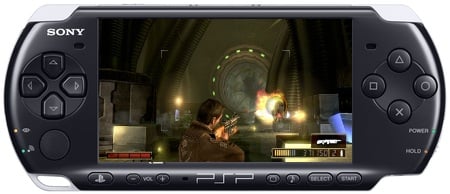
Resistance:Retribution on the PSP
In contrast, the DS Lite, like the Nintendo Wii, is much more of a ‘fun’, family-oriented gadget aimed at casual gamers of all ages. With a typical price of around £100, it’s far and away the cheapest of the handheld consoles, and the innovative dual-screen design has encouraged games developers to come up with a wide range of ingenious games designs.
You can get versions of FIFA ’09 and Force Unleashed for the DS Lite, priced at £25–20 like their PSP counterparts, but the top selling Nintendo games tend to feature cartoon characters such as Super Mario and Sonic the Hedgehog that appeal to younger children.
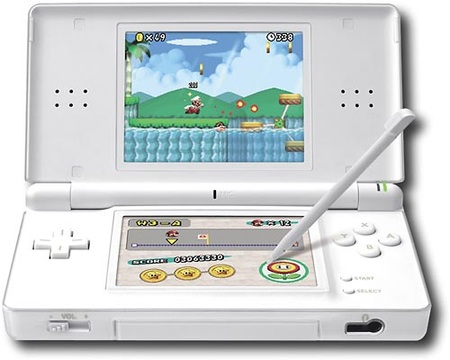
Nintendo’s DS Lite: fun for all the family?
At the other end of the spectrum there are what Nintendo refers to as its "generations" games, which appeal to a much wider age group than most conventional computer games do. Titles such as Cooking Guide and the enormously popular Brain Training have attracted an older audience that wouldn’t touch the PSP with a bargepole.
The twin screens may be a bit of a strain on the eyes – they’re both 3in in size, although they actually seem smaller if you sit the DS alongside any of its rivals – but the stylus control system deserves some of the credit for the console’s success. The gamepads and buttons of the PSP might be off-putting for older people, but anyone can use a stylus to tap on the screen. The DS is undoubtedly a good choice for younger kids, and also for anyone that likes to while away boring train journeys with a crossword or Sudoku puzzle.
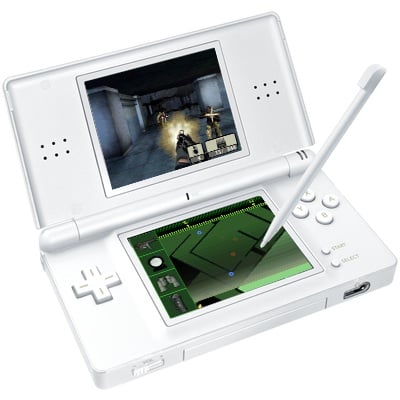
But not just the kids: Call of Duty 4
It’s not enough to just produce a good games machine these days. What all the big companies are trying to do now is to develop a ‘platform’ – a device that acts as the springboard for a much wider range of activities. The iPod Touch is a good example of this. The original iPod was a simple MP3 player, but over the years Apple has added more and more features to the product, culminating in the multimedia extravaganza that is the iPod Touch.
The Touch is first and foremost a superlative music and video player, and even has its own movie rental section in the online iTunes Store. It has wireless networking features that let you browse the internet, check your email or watch videos on YouTube or the BBC iPlayer. It can even do a clever triangulation thingy that is almost-but-not-quite GPS, but which can still locate your position on a map and give directions to the destination of your choice. To be honest, the gaming aspect of the iPod Touch is merely icing on the cake.
Sony has taken a similar approach with the PSP. It’s more of a ‘pure’ gaming device than the iPod, of course, having been designed specifically for games in the first place. However, Sony always had films and video in mind for the PSP too. The UMDs (Universal Media Disks) that are used to store PSP games can also hold films as well, and while the UMD format probably hasn’t been the success that Sony hoped there are occasional film releases, such as the Simpsons Movie, that do sell well in this format.
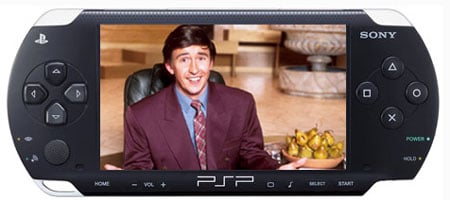
PSP owners can view movies and TV shows…
The PSP also has a slot for a Memory Stick, which makes it easy to transfer your own music and video files onto the PSP. And, needless to say, the PSP has wireless networking built into it, along with a web browser. The networking option was initially intended for multi-player gaming, but Sony has recently started to expand the PSP’s online capabilities with features such as the Go! Messenger chat system, and it has also got together with Skype to produce a PSP version of the popular VoIP program that lets you make cheap online phone calls.
You can buy a PSP webcam for video-chat and a GPS add-on called Go! Explore — though at £99, this costs almost as much as the PSP itself. Sony has even launched a movie rentals and TV subscription service for the PSP called Go! View — £5 per month from www.goview.tv.
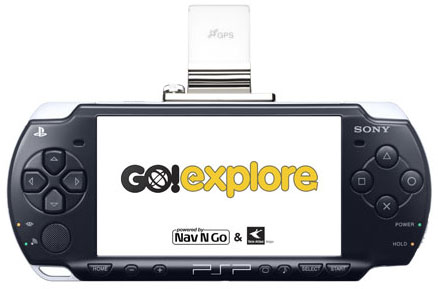
…or add GPS for route-planning
Sadly, this is one area where the DS is a bit of a disappointment. It does have wireless networking features, and a number of DS games include an online multi-player option. However, Nintendo doesn’t really seem to have thought the networking side of things through properly. The DS doesn’t like the wireless encryption used on many ordinary wireless routers, and we were unable to get it to work with our bog-standard BT HomeHub router.
This essentially means that the wireless networking will only work on public ‘hotspots’ that don’t have any security or encryption turned on. And, if you want to browse the web, you’ll need to pay an extra £25 for the separate Nintendo Web Browser. The built-in Pictochat messenging system built into the DS Lite allows you to send messages directly to other DS users, but only if they’re in close range, so its online communications features are a lot more limited than that of the PSP or iPod Touch. It’s not really designed as a music or video player either, although you can buy an MP3 Player add-on pack for £18. By the time you pay for all those add-ons — and a memory card for your music — you’re getting close to the price of the 8GB iPod Touch.
Ultimately, then, these three devices are very different, which means that it’s not actually that hard to choose between them. The PSP is the mobile games machine for the testosterone-filled young guys that like to frag the living daylights out of each other on their PCs, Xboxes and PlayStation games consoles. Its video and internet communication features are an added bonus — we’d love to get Skype phone calls on the iPod Touch — but it’s basically all about high-speed action gaming.
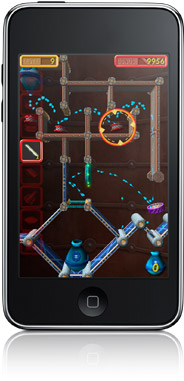
Touch: Good for gaming, great for media
The DS Lite is the flip-side of the gaming coin. It has its fair share of action games, but Nintendo’s real focus is on more family-oriented games that appeal to everyone from young kids through to their grandparents. Its online and communications capabilities are relatively limited, but it’s a great gadget for passing the time when you’re stuck on a train or plane, or for keeping the kids quiet on the back seat of the car.
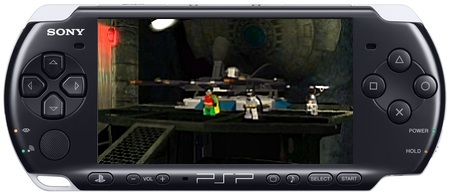
PSP: best for action games
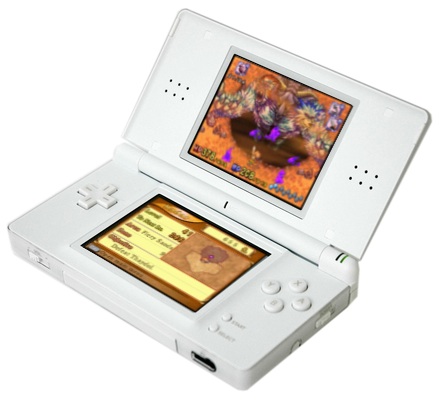
DS: best for family fun, but not good for the net
As for the iPod Touch, it certainly has a lot of potential for playing games, but it’s not yet ready to go head-to-head with dedicated gaming devices like the PSP and DS Lite. It is first and foremost a terrific music and video player, which is further enhanced by its impressive internet features and oh-so-slick touchscreen technology. Buy it as a media player and treat the current crop of iPod games as icing on the cake. But if games are what you’re after then Sony and Nintendo are still your top two choices.